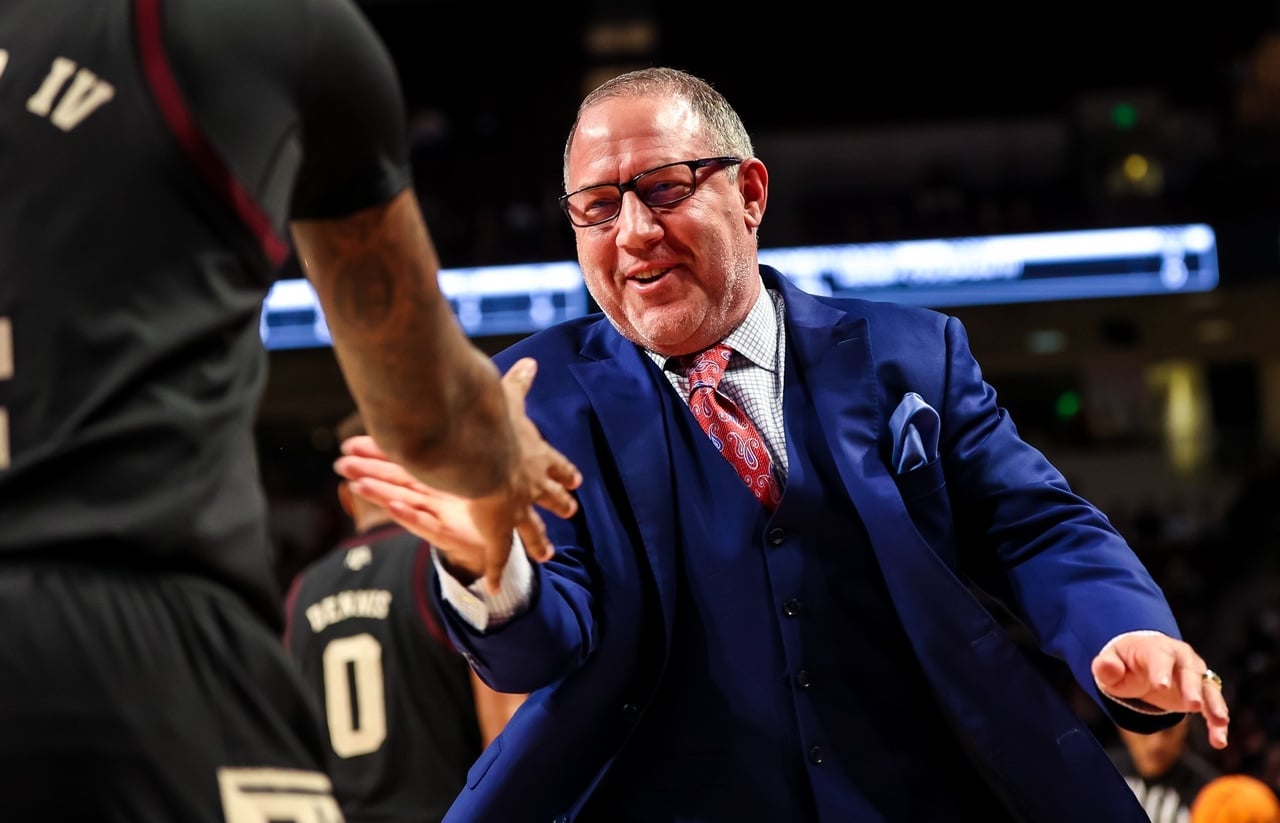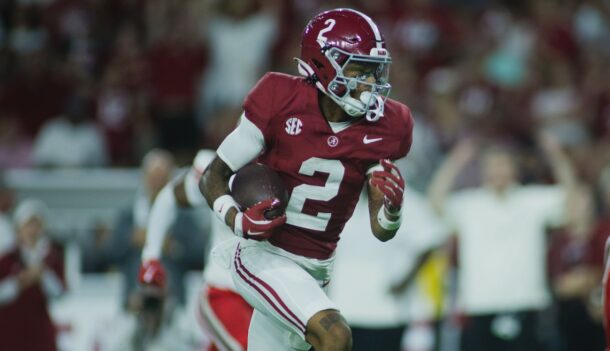
SEC Tournament: Why Buzz Williams has the makeup of being a top-10 coach in the not-so-distant future
Let’s clap it up for Buzz Williams.
He’s earned it. In Year 4 at A&M, he’s been everything that Aggie fans could’ve hoped for and then some. Is that a strange thing to say about someone who has yet to appear in an NCAA Tournament at his current job? Sure. I’d also argue that his team was robbed of a bid in Year 3 after reaching the SEC Tournament final. I’d also argue that an anti-Williams take of “he hasn’t even reached the NCAA Tournament at A&M yet” has essentially 3 more days of shelf life before his Aggies punch their ticket on Selection Sunday.
Ahead of the SEC Tournament, wherein the Aggies will compete as the No. 2 seed with their first double bye in 7 years, Williams was named AP SEC Coach of the Year. Again. It’s his second time earning that award since his arrival in College Station in 2019. Get used to it.
Another thing we should probably get used to? The idea that Williams is on his way to becoming a top-10 coach in college basketball.
I’ll admit there’s a touch of recency bias there. In his past 26 games against SEC competition, he’s 22-4. Just for a little perspective on how dominant that is, John Calipari’s best 26-game stretch against SEC competition was from 2014-15 in which his Kentucky team went 24-2 against the conference (he also matched that against SEC competition in 2015 combined with his first 5 SEC games of 2016 and he had another 24-2 stretch from the end of the 2011 season through the SEC Tournament in 2012).
It’s strange to say that Williams is “on the rise” because he’s a 50-year-old guy who is in Year 16 as a Division I head coach. His rise was hardly meteoric. He’s still the same letter-writing guy — he writes 180 notes per month and reads 1 book per week — who got his start in the early-90s as a floor maintenance man/student assistant at Navarro College (Texas), where his energy earned him the nickname “Buzz.” He’s never been fired, yet he left respected programs for other jobs twice, including his most recent move from Virginia Tech to Texas A&M after a 2018-19 season that concluded with Williams’ Hokies falling in a Sweet 16 thriller against Zion Williamson-led Duke. Scott Woodward’s last big splash as A&M’s athletic director was poaching the respected Williams, who earned a 6-year deal worth $24 million.
Worth every penny? Absolutely.
That’ll be the case even if A&M flames out in the first round when it plays in its first NCAA Tournament in 5 years. The goal for the Aggies was always consistency. Outside of the 6-year stretch from 2006-11, A&M has never had consecutive NCAA Tournament appearances and it has never reached an Elite Eight. Football-focused or not, that’s hard to fathom at a place with such deep pockets. The goal of any non-blue-blood should always be to check these boxes:
- Hire a head coach who provides stability
- Consistently be one of the better teams in the conference
- Get better as the season progresses
- Get to the NCAA Tournament annually
(Five years ago, I would’ve also had “sign elite recruits,” but the transfer portal has changed the way talent is evaluated in college hoops.)
So far, Williams checked all of those boxes. This year somehow one-upped last season’s progression. Well, that’s because the Aggies were a floundering disaster prior to SEC play.
Losing to the likes of Murray State, Colorado, Boise State and Memphis squashed the preseason buzz after being picked to finish 6th in the SEC preseason media poll, but losing to Wofford at home to fall to 6-5 was the low point.
That night, Williams sat at the postgame press conference and shook his head before he said anything. It was only the second time in his career as a head coach in which he lost a “guaranteed” game (that’s when the opponent collects a paycheck for a nonconference game). He admitted that he couldn’t figure out why his team was so unpredictable from half to half.
“The inconsistency and not knowing is not a good thing,” Williams said back in December. “The inconsistency and not knowing is on the head coach.”
At that point, Williams was still figuring out the identity of his team. Specifically, he didn’t know the right rotations at that point.
So what turned things around?
For starters, the Aggies figured out how to close games. They cleaned up the late-game turnover issues that plagued that rough start. A team not known for pushing the tempo averaged 4 less 3-point attempts per game after the Wofford loss and it instead worked to get better looks in the half-court. As a result, A&M became the No. 1 team in America in free throws made and free throws attempted per game.
Defensively was where the Aggies showed their greatest improvement. Through the Wofford game, A&M surrendered 70.4 points per game. After that loss, they allowed just 63 points per game, which was an even bigger turnaround than that number might indicate because unlike those first 11 games, 18 of the last 20 were against SEC competition. Only 3 of A&M’s 20 post-Wofford opponents hit 70 points.
It also helped that Wade Taylor IV emerged into a legitimate go-to scorer who could take over games, just as he did in a 28-point effort to close the regular season with an upset win against No. 2 Alabama. It was a fitting way to cap a regular season turnaround for the ages.
“We stayed together throughout this whole process and … we’re not done,” Taylor said (via AP). “Just to finish up conference with the most wins in conference in school history is the end of chapter of that book we just wrote. So now it’s time to start Volume 2.”
It’s hardly Volume 2 on Williams’ career. This wasn’t the first time or the last time that he got one of his teams to buy in and play its best basketball late in the season (his 2013 Elite Eight team at Marquette started 7-3 with a 49-47 loss at Green Bay). You know, like all great college coaches do.
You could probably say that about Tom Izzo’s teams at Michigan State, and it wasn’t long ago when that was the DNA of John Calipari’s teams at Kentucky. Williams still has a ways to go in order to be in the same breath as those 2, both of whom each have a national title and half a dozen Final Four berths to speak of (Izzo actually has 8). Of course, they’re both in their 60s, as are Bruce Pearl, Bill Self, Mark Few and Kelvin Sampson, all of whom would be on the short list for the best coaches in the sport.
Williams, on the other hand, just hit the half-century mark this past September. Where will he be when he’s 60? These things aren’t always linear, though given how much he’s risen above preseason expectations in 3 of 4 years at A&M, how can you not be optimistic about his future? Including his overhaul at Virginia Tech, Williams rebuilt 2 different Power 5 programs and helped turn basketball into a major draw at football-focused places.
All eyes are on Williams to take that next step. He knows as well as anyone that a 17-3 run to close the regular season is great, but legacies are defined in March. So much of Williams’ legacy feels like it hasn’t been written yet, which is ironic considering his prolific letter-writing ways.
Perhaps a storybook run awaits.
Connor O'Gara is the senior national columnist for Saturday Down South. He's a member of the Football Writers Association of America. After spending his entire life living in B1G country, he moved to the South in 2015.







